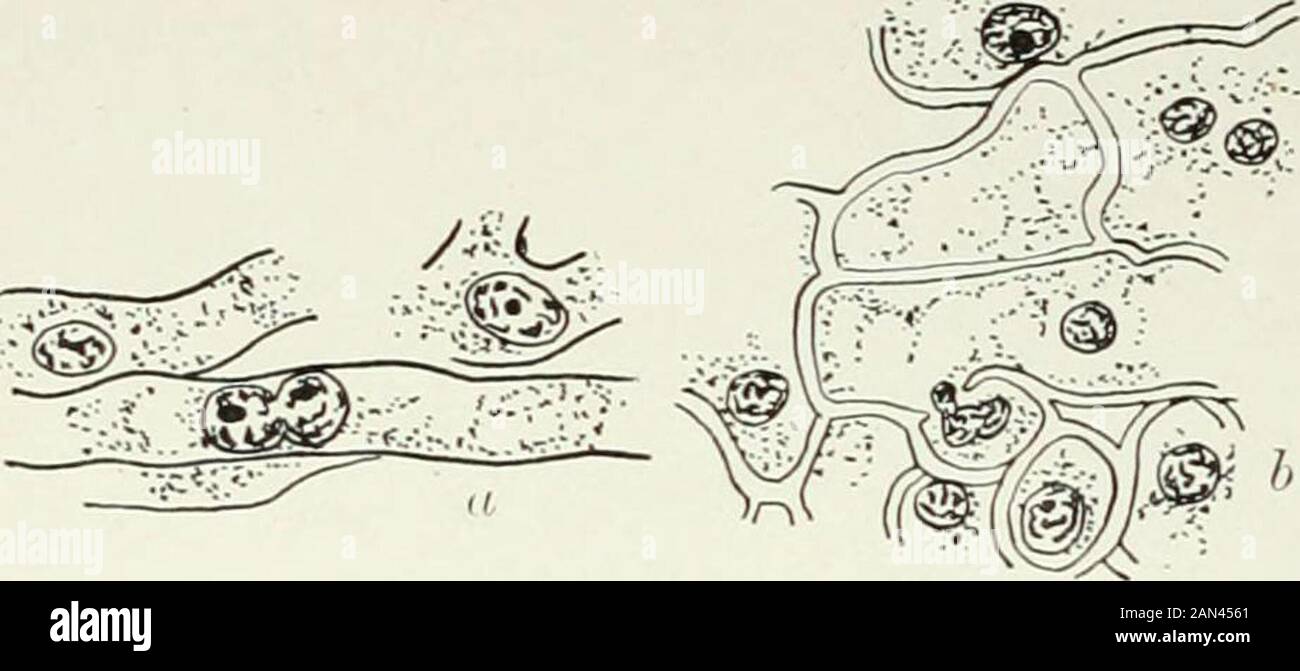Fungi, Ascomycetes, Ustilaginales, Uredinales . Fr.) Sacc; very young ascocai p,x soo. In another species of this genus, Humaria rutilans1, reduction has gone yetfurther and not even an archicarp is produced. The apothecium arises asa dense weft of tangled filaments, which for a time differ from one anotheronly in the relatively thick walls of the outer hyphae, and the richer proto-plasmic content of the inner (fig. 69). Each cell of the weft contains oneor a few nuclei. After a while the nuclei in the central part of the massmay be seen to be of two sizes, and the smaller have been found to f

Image details
Contributor:
The Reading Room / Alamy Stock PhotoImage ID:
2AN4561File size:
7.2 MB (211.7 KB Compressed download)Releases:
Model - no | Property - noDo I need a release?Dimensions:
2365 x 1057 px | 40 x 17.9 cm | 15.8 x 7 inches | 150dpiMore information:
This image is a public domain image, which means either that copyright has expired in the image or the copyright holder has waived their copyright. Alamy charges you a fee for access to the high resolution copy of the image.
This image could have imperfections as it’s either historical or reportage.
Fungi, Ascomycetes, Ustilaginales, Uredinales . Fr.) Sacc; very young ascocai p, x soo. In another species of this genus, Humaria rutilans1, reduction has gone yetfurther and not even an archicarp is produced. The apothecium arises asa dense weft of tangled filaments, which for a time differ from one anotheronly in the relatively thick walls of the outer hyphae, and the richer proto-plasmic content of the inner (fig. 69). Each cell of the weft contains oneor a few nuclei. After a while the nuclei in the central part of the massmay be seen to be of two sizes, and the smaller have been found to fuse in 1 Humaria rutilans |Kr.| Sacc. = Peziza rutilans Fr. in Boudier, horn r, PI. 315.G.-V. 8 H4 DISCOMYCETES [CH. pairs (fig. 70 a), giving rise to the larger. Sometimes in connection withthis process a nucleus migrates through the wall from one cell to another(fig. 70 b), as in prothallia of ferns. Thus in H. rutilans, where the sexualorgans are completely lacking, normal fertilization is replaced by the unionof vegetative nuclei in pairs.. Pig. 70. Humaria rutilans (Fr.) Sacc; a. fusion in a vegetative hypha; b. migrationof nucleus from one vegetative cell to another; both x 1100. The cells which contain fusion nuclei now ive rise to ascoffenoushyphae, while, from the rest, the paraphyses and cells of the outer sheatharise. The asci are very large, and their nuclei particularly clear. The numberof chromosomes in the nuclei of the ascogenous hyphae, and in the firstand second divisions in the ascus and in the prophase of the third is sixteen(figs. 71, 72). In the third telophase eight have been recorded by Maire andby Fraser (fig. 73), and sixteen by Guilliermond (fig. 74).